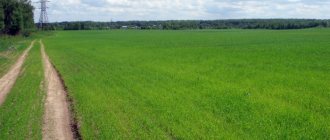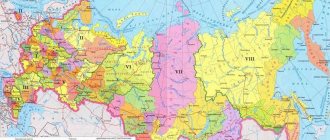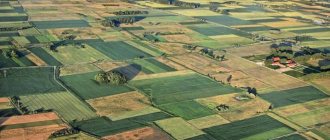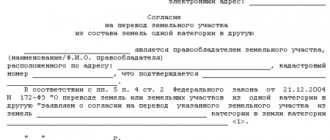All territories in the Russian Federation are divided into sections depending on their composition. Regardless of who owns the land, land plots are necessarily assigned a category - a legal regime that establishes acceptable ways of using real estate.
The owner (land user) does not have the right to change the category independently - a strictly regulated procedure for transfer and registration allows to avoid abuses during the operation of the site.
Citizens most often face the need to transfer a plot from one category to another when it comes to small plots of land received many years ago for use from the municipality or a horticultural non-profit partnership (hereinafter referred to as SNT). Even registration of ownership or privatization of such land does not give the owner the official right to build and register on this territory a residential building or other object that does not meet the target requirements. To register a building with the state, it is necessary to obtain permission to transfer land from one category to another.
Categories of land in Russia
The Land Code (hereinafter referred to as the Land Code of the Russian Federation) divides land into the following categories:
- Industrial. Plots in this category are allocated for the construction of transport routes and buildings, buildings for the defense and security of the country, for energy, communications and scientific programs buildings and other special purposes.
- Lands of populated areas (hereinafter referred to as ZNP). Plots allocated for the development of residential properties. The main feature of such lands is that they cannot be located on land territories for other purposes or in private ownership.
- Agricultural purposes (hereinafter referred to as Agricultural Purposes). Land resource necessary for the production of agricultural products: pastures, arable lands, plots for gardening and horticulture, forest shelterbelts, reservoirs for growing fish and lands of similar properties.
- Water fund.
- Specially protected. These include territories that are withdrawn (partially withdrawn) from general circulation and are of valuable importance.
- Forest fund (read: how to get forest for free from the state).
- Reserve lands. State plots that have not been transferred for use to citizens or organizations and have not been sold into ownership.
Find land use and development regulations approved for your municipality
This is an important document that must be published on the municipal administration website.
There, in the section “Town Planning Regulations,” the types of permitted use of land located on the territory of the municipality are prescribed. All of them are divided into three groups:
- main type (this is what the land is primarily purchased for - for example, for building housing or growing crops),
- auxiliary type (it complements the main type - it allows, for example, the construction of not only a house, but also a garage and other auxiliary buildings),
- and a conditionally permitted type (involves expanding the forms of land use - for example, not only gardening, but also raising poultry and livestock).
Transferring a site from one category to another: what you need to know
Changing the purpose of a land plot today is regulated by the provisions of the Land Code of the Russian Federation and Federal Law No. 172-FZ dated December 21, 2004 (current edition dated July 29, 2017, hereinafter referred to as Federal Law 172). Before starting the procedure for transferring the category of land plot to another legal status, the owner (user) will need to clarify whether the legislation can allow such changes. The provisions of Federal Law 172 establish restrictions and mandatory conditions that must be observed to change the category of a particular type of land:
- For ZSHN. The transfer of such valuable plots for the state on a general basis is prohibited (clause 2 of article 7 of Federal Law 172). Exceptional circumstances allowing changes are provided for plots whose value is lower than 50% of the average cadastral price of land in the region. The law includes the following reasons for changing the category as such conditions:
- conservation of the territory;
- creation of especially valuable zones;
- expansion of the ZNP;
- planned construction of industrial structures;
- transfer to the water or forest fund, to land reserve zones, if the territory of the agricultural reserve has become unsuitable for exploitation;
- construction of roads, power lines, pipelines;
- for defense needs, implementation of international government projects;
- planned development of mineral resources on site;
- placement of social facilities, including for education and healthcare, if there is no other territory for the construction of this facility.
You may be wondering how to rent agricultural land.
- RFP. It changes along with the expansion (decrease) of the limits of the settlement (Article 8 of Federal Law 172).
- Industrial zones can be transferred to other categories without special restrictions (Article 9 of Federal Law 172), but subject to complete restoration according to a reclamation plan.
- Lands with a special status (protected, valuable). They are transferred to another category extremely rarely due to the loss of valuable properties (Article 10 of Federal Law 172). Conversely, any territory, with the exception of the ZNP, can receive the status of a specially protected zone, if there are conditions for creating a tourist, environmental or other similarly valuable zone in this area.
- Forest and water areas. They are transferred when creating particularly valuable areas or constructing an object of state (municipal) importance, and are also integrated into the expanding boundaries of the settlement (Articles 11, 12 of Federal Law 172).
It should be clarified that restrictions on the transfer of a specific territory to another category may be imposed by special regulations. You can find out for sure whether the transfer procedure can be carried out for a specific plot by sending a request in advance to the land and property department of the municipality in whose department this land is located.
The process of changing the category of land: step-by-step instructions
The owner of the plot or land user has the right to initiate the transfer procedure, which can be citizens, representatives of a legal entity (LE), individual entrepreneurs (IE) or communities of small indigenous peoples of Russia, and in some cases - the competent bodies of state (municipal) authorities. Step-by-step instructions for changing the category of land are as follows (Article 3 of Federal Law 172):
Step 1. Preparing a package of documents
A complete list of documentation is contained in Article 2 of Federal Law 172:
- Passport or other identification document of the applicant.
- An extract confirming the registration of an individual entrepreneur or legal entity (if necessary).
- Extract from the Unified State Register of Real Estate. If the owner (user) does not have a paper copy with a seal, a request for receipt will be sent by the executive authorities.
- Documents confirming the acquisition of ownership of land (sale and purchase agreement, certificate of inheritance, etc.) or consent from the owner if the site is operated under the right of use.
- Conclusion of the environmental assessment.
The latter document is not required for every category of real estate, but under the conditions determined by federal laws.
In addition to the above, additional documents may be requested from the applicant in accordance with federal (municipal) regulations and decrees of the Government of the Russian Federation (clause 2 of article 2 of Federal Law 172).
Step 2. Submit an application (petition)
Depending on the ownership of the plot of land, the application should be submitted to the land and property department of the regional government or local government.
The document is drawn up in free form or on a form approved by the competent authorities. A sample of filling out an application can be found on information stands or on the website of the department that accepts such applications. When compiling, you must indicate:
- cadastral number of the claimed plot;
- the applicant's rights to land;
- the current category of allotment and the category of the planned transfer;
- justify the reason for transfer to this category.
Step 3. Making a decision and drawing up the corresponding act
An accepted application is considered within 2 months (by city and municipal authorities) or 3 months (by the regional government or the Government of the Russian Federation). Notification of transfer (refusal to transfer) of a land plot to another category is sent to the applicant within 2 weeks from the date of the decision.
If the result is positive, the land and property department draws up an act on transferring the land to the declared category. There is no need to re-register other land documentation.
Step 4: Register a category change
A copy of the act is sent from the local (regional) administration to the territorial department of the Federal Service for State Registration, Cadastre and Cartography (Rosreestr department) within ten days from the date of approval of the decision. Changes are made to the Unified State Register on the basis of this act (Article 5 of Federal Law 172).
The service of notifying Rosreestr about a change of category is provided to the applicant free of charge. For the provision of government services for making changes to the Unified State Register of Real Estate, the owner (user) of the site will need to pay a state fee in the amount of 350 rubles. (Article 333.33 of the Tax Code of the Russian Federation).
After registration, the owner of the plot can begin to use the plot in accordance with the new legal status of the land.
Procedure for consideration of the issue
To prepare materials on the transfer of land from one category to another, a commission is assembled at the federal, regional or local government level. It includes officials from the geodetic and land management services, environmental protection, natural resources, the Ministry of Emergency Situations, forestry, sanitary supervision, as well as representatives of the executive branch of the level at which the application is being considered.
Within 10 working days, the commission conducts an inspection of the territory applied for transfer , after which it draws up an inspection report, which is sent to the executive authorities. This act indicates the cadastral number of the site, the correspondence of the boundaries of this territory with the data specified in the cadastre, as well as compliance (non-compliance) with the rules for use of the territory by the owner.
Based on the act presented by the commission, the executive body makes a decision to transfer the site to another category or refuses to carry out the transfer (indicating the reason).
IMPORTANT! The refusal can be appealed to a higher authority or court.
Refusal to change the category of land
The applicant may be refused at the stage of submitting the application. Reasons for this may be that the person does not have the right to submit a petition, as well as incorrect or incomplete execution of the required attached documents. To re-apply, you must eliminate all the shortcomings indicated in the refusal documents.
An official refusal to transfer a plot of land to another category is made on the grounds listed in Art. 4 Federal Law 172:
- restriction (prohibition) on transfer to another category imposed by current legislation;
- the declared category contradicts the intended purpose of the allotment;
- The environmental state examination has identified the negative consequences of the upcoming transfer.
Another reason why a transfer cannot be made is if the cadastral value of the declared territory is too high (more than 50% relative to the average value for the region). In any of these cases, the applicant will be returned the full package of documents within 30 working days from the date of submission of the application, notifying him of the reason for the refusal.
The applicant can challenge the decision through the court and, if the court decides positively, send a new petition. The appeal procedure is as follows:
- Obtain the act from the property and land department.
- Draw up and submit a statement of claim to declare the drafted act illegal. Attach documents to the application:
- a photocopy of the issued act;
- a copy of the application and accompanying documents;
- documentation confirming the illegitimacy of the refusal or permission to transfer;
- receipt of payment of state duty;
- other documents related to the trial.
- Having received notice of the place and date of the hearing, appear in court at the appointed time.
- If the court satisfied the requirements of the statement of claim, obtain a copy of the court decision from the office.
- Submit a second petition, attaching the court decision to the package of documents.
Conditions when it is impossible to change
Article 4 of Federal Law No. 172 “On the transfer of lands or land plots from one category to another” imposes a ban on changing the category of land in the following cases:
- If discrepancies are identified between the territory requested for transfer and the documents attached to the land (documentation of the land plot, territory layout, etc.).
- If a negative decision is made by environmental experts (in some cases, such an examination is mandatory).
- If there are restrictions for a certain period imposed by the Federal Laws of the Russian Federation.
The appeal process using an example from judicial practice
The owner of a dacha plot, citizen P., filed a statement of claim in court with a request to declare illegal the act of refusal to transfer the plot from agricultural land to the ZNM category. Citizen P. justified his claim by the fact that in connection with the expansion of the residential microdistrict planned for 2021 - 2019, the decision of the meeting of the district Duma of the Starodvorsky municipal district No. 321-r approved the master plan for the urban settlement of Veseloe, Starodvorsky district, according to which his dacha was included within the city limits n. Merry.
On July 1, 2021, citizen P. sent a petition to the administration of the Starodvorsky district to include his plot in the territory of the Veseloye settlement and transfer the dacha land from the ZSHN category to ZNP for individual housing construction (IZHS).
The administration of the Starodvorsky district made a decision to refuse to include the site within the boundaries of the Veseloye settlement due to the fact that construction of a residential complex has not yet begun, due to which the boundaries of the village are expanding.
Having considered the presented materials, the court came to the conclusion that the act of refusal issued in response to the petition of citizen P. was unfounded. In accordance with paragraph 1 of Article 7 of Federal Law 172, the expansion of the territory of an urban settlement, fixed by urban planning, is a legitimate reason for the transfer of dacha ZSHN to the declared category of ZNP
On the basis of this, the court made a decision to invalidate the act of the administration of the Starodvorsky district, and also recognized citizen P.’s right to include the land belonging to him in the town of Veseloye, Starodvorsky district, and the right to transfer the declared allotment from the ZSKHN category to the ZNP.
Why change the purpose of the site
Each land plot, in accordance with its intended purpose, is included by the state in one or another category of land. The use of a land plot for a purpose other than the intended purpose is prohibited.
It is unacceptable to open a trade enterprise on a land plot intended for running an individual subsidiary plot or to build an apartment building on a land plot that is part of agricultural land.
Important! The need to change the purpose of a land plot may arise for the following reasons:
- a person who owns a land plot wants to make money from the sale of this land plot. Thus, land plots classified as residential land are much more expensive than equivalent land plots classified as agricultural land;
- the owner of a land plot wants to organize an industrial or commercial enterprise on this site.
- the person who owns the land plot has decided to build an apartment building on the territory of this plot, but the category of land to which this land plot is assigned does not allow the construction of apartment buildings.
If the owner of a land plot does not change the category of land and begins to use this land plot for a purpose other than the intended purpose, this constitutes an administrative offense.
Based on the norms enshrined in the Code of Administrative Offenses of the Russian Federation, the person guilty of committing this unlawful act will be fined:
- for using a land plot not for its intended purpose, the fine will be 1% of the cadastral value of this land plot, but not less than 10,000 rubles;
- for failure to conduct agriculture on a land plot that is part of agricultural land, the fine will be 0.5% of the cadastral value of this land plot, but not less than 3,000 rubles;
- for failure to construct residential real estate on a site allocated for individual housing construction, the fine will be 1.5% of the cadastral value of the land plot, but not less than 20,000 rubles.
Attention! Our qualified lawyers will assist you free of charge and around the clock on any issues. Find out more here.










